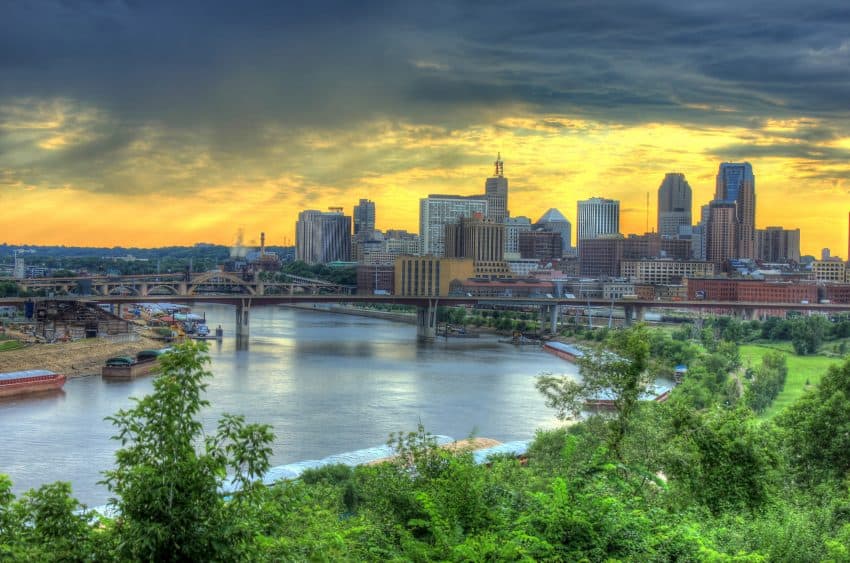Mini-Apple No More: Minneapolis Steps Into the Spotlight
By Kelly Westhoff
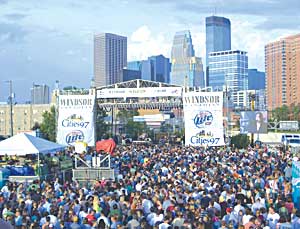
When I was growing up, my father traveled for business. He flew off to London, Hong Kong, Beijing, and Paris. But most of the time, he made trips to New York City. He brought back goodies and knick-knacks boasting that familiar “I Heart NY” logo.
Long before I ever got to go to the city that never sleeps, I knew that New York was called “the Big Apple.” I latched on to this nickname, perhaps because it evoked a vivid image in my childhood mind, yet the moniker also appealed to me as I lived in a city that went by the opposite claim: the Mini-Apple.
There was the obvious play on words — Minneapolis/Mini-Apple — yet beyond that, explained my dad, Minneapolis did share some attributes with New York City.
A subway system runs beneath the Big Apple connecting one corner of the city with another while in Minneapolis the far ends of downtown are connected by a skyway system.
The skyways are an enclosed system of sidewalks located one story up from the ground and thus bridging over the streets below.

Office buildings, hotels, condos, parking ramps, theaters, restaurants, the YMCA, schools, and sports arenas can all be reached via the skyway. It is the biggest skyway system in the world.
While New York is often thought of as the nation’s literary mecca, Minneapolis is also home to an impressive number of bookstores, small presses, and authors. In fact, in 2007, Minneapolis was declared the most literate city in America by Jack Miller, president of Central Connecticut State University, who has been ranking the country’s literary bright spots since 2004.
Minneapolis’s twin city, St. Paul, landed at number three on the 2007 list, making the combined metro area a shining star of bookishness. New York, on the other hand, didn’t even make the top ten.
Literary types tend to like the stage. While New York is stuffed with theaters and museums, so is Minneapolis. The city might lack New York’s star power, but its people have a reputation for being cultured and educated.

My father told me this when I was a girl, and I never questioned him as my Minneapolis childhood was filled with trips to museums, Orchestra Hall, ballet performances, and musicals. The auditoriums were always full, so I had no reason to doubt his claim. I never once felt like I was the only kid going to the show.
I’m no longer a little girl, but I’m still living in the Minneapolis area and I’m still attending plays, lectures, art crawls and readings on a regular basis. As I’ve grown older, my city has grown more sophisticated and diverse in its art offerings.
The past few years have brought a lot of national recognition, art funding, and gallery openings to Minneapolis.
The arts are exploding here and the city is moving out of the shadow of New York to stand on its own as a cultural center. Minneapolis is no longer the Mini-Apple.
Guthrie Theater
The Guthrie Theater is a beloved Minneapolis institution and now it’s a beloved Minneapolis landmark. Its new digs on the Mississippi River opened in the summer of 2006. Its striking blue exterior was designed by Jean Nouvel, an internationally renowned architect.

Beyond its three stages and two restaurants, the building also features something called a cantilever, which, to Minnesotans, looks like a big skyway to nowhere.
You can visit the building even if you don’t have theater tickets, so there’s just no reason why a trip to Minneapolis shouldn’t include the Guthrie. If you’ve got a hankering for Shakespeare, the Guthrie is your best bet in town. Rush tickets go on sale 10 minutes before any performance but the line forms about an hour before that.
Hennepin Theatre District
Three different theatres in three downtown city blocks—the Orpheum, the State, and the Pantages—make up the Hennepin Theatre District. If you’re looking for a Minneapolis rendition of a Broadway musical, the Orpheum and the State are where you need to be.
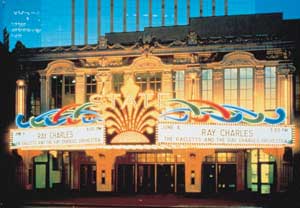
Both theaters also host nationally-recognized performers like David Sedaris, Ira Glass, Ben Harper, and Cedric the Entertainer.
The Pantages hold shows of a more intimate nature as its capacity is smaller. All three theaters have graced Hennepin Avenue since the early 1900s and all three have undergone extensive and beautiful renovations.
Children’s Theater Company
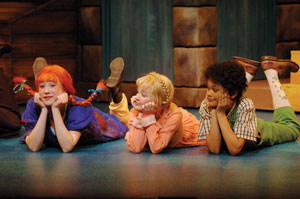
The Minneapolis Children’s Theater is the largest children’s theater in North America and in 2003 it, too, earned a Tony Award for Best Regional Theater. Bolstered by this national recognition, it added an expansion in 2005 designed by Michael Graves.
Just because it’s got the word “children” in its name, don’t expect a line up of simple shows. Yes, it caters to families with productions of Frog and Toad and Mrs. Piggle-Wiggle, but the performances are first-rate as the theater’s status attracts young acting prodigies from across the country.
Jungle Theater
With just 150 seats, any experience at the Jungle Theater is bound to be intimate. The theater likes to produce plays by area playwrights and regularly showcases emerging artists. Away from the crowds of downtown, it’s set in the hip LynLake neighborhood surrounded by independent restaurants and bars.

After the show, make your way two blocks over and bowl some frames at the Bryant Lake Bowl, which also houses a small theater.
Brave New Workshop
Who doesn’t love a night of killer comedy? The Brave New Workshop has the formula down pat. It’s been writing and performing original comedy routines since 1958, longer than any other satirical theater in the United States.
And how can you pass up this deal? On Friday nights at 10 pm and Saturday at midnight, the improv show is just $1. The bar opens an hour before the show. Get there early and have a drink. The show will just get funnier.
Minnesota Fringe Festival
If you time your trip to Minneapolis just right, you can take in the Minnesota Fringe Festival, the largest non-juried theater festival in the country. After 25 years of significant growth, the 2019 Festival will showcase nearly 700 performances of over 130 shows.
A Fringe viewing requires an open mind as the performances are chosen by lottery, not by a panel of critics. My trips to the Fringe have produced a tragic drama played out through flamenco dance, a touching, gay love story, and a stage full of completely naked men.
Museums
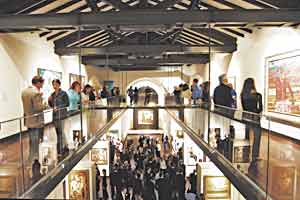
Art buff? History buff? Minneapolis has a diverse selection of museums well-supported by vast local memberships. The city’s art scene is still growing and expanding.
Minneapolis Institute of Art
The Minneapolis Institute of Art (MIA) is Minnesota’s largest art museum and in 2006 it gained more gallery space when it opened a new wing designed by Michael Graves. The general collection is huge; it numbers about 100 thousand objects. The Asian collection is large and holds several important pieces. Admission is free, except for touring exhibits. The museum is closed on Mondays.
The MIA also owns the Purcell-Cutts House, a home designed by Frank Lloyd Wright. The home is open for tours the second weekend of each month, but you must call ahead to reserve space and double-check arrival information.
Walker Art Center
The shiny, boxy outer shell of the 2005 addition to the Walker Art Center was designed by Swiss architects Herzog & de Meuron and hints at the contemporariness visitors will find inside. The Walker is an ultra-modern art museum; everything in its permanent collection was produced after 1945.

In 2007, the Walker knocked itself out to bring big-name shows to town: a Picasso exhibit and a Frida Kahlo exhibit kept the museum hopping during the day. After hours, Esker Grove keeps the place busy. The museum does charge admission, but arrive on the first Saturday of the month, and entrance is free. Every Thursday evening is free as well.
Minneapolis Sculpture Garden
The Minneapolis Sculpture Garden is across the street from the Walker and is home to the city’s most iconic image: Spoonbridge and Cherry. When the weather is nice, the cherry spurts water into the air misting passersby. The sculpture garden hosts more than 40 different works and is a perfect place to stroll.
It’s also a favorite photo op for local brides, so if your trip coincides with a sunny Saturday, don’t be surprised to spot entire wedding parties running about. If you arrive between Memorial and Labor Day you can pass a weekend playing mini-golf on the lawn.
Frederick R. Weisman Art Museum
The stainless steel exterior of the Weisman Art Museum glints in the sun. Located on the banks of the Mississippi River, it is also on the University of Minnesota campus adjacent to the bustling Coffman Union.
Because it’s associated with the university, it calls itself a “teaching museum.” Admission is always free and visitors can expect to find 20th-century art. The Weisman was designed by Frank Gehry, who has agreed to return and expand the building. The new space has a completion date of 2009.
Museum of Russian Art
Housed in a renovated church, the Museum of Russian Art features the 20th century, Soviet-era, Russian art. It is the only museum in North America dedicated to Russian artists. The museum is closed on Sundays and charges admission. It’s also located far outside the bounds of downtown Minneapolis. Still, it’s worth the taxi charge for out-of-towners as the church setting alone lends a hushed and sacred air to the viewing experience.
Mill City Museum
The Mill City Museum traces the rise of Minneapolis from its beginnings as a flour mill town on the banks of the Mississippi. A bakery operates inside the museum and while it sells goodies to eat, it’s also intended to call attention to the importance of flour.
Beyond the yummy bakery smells, the museum draws on the visual, too. It’s housed in an old flour mill that exploded in 1878, burned in 1928, and burned again in 1991. The current museum is built around what was left, including partial walls, twisted iron beams, and sooty bricks. The museum is closed on Mondays and charges admission.
Literature
Minneapolis is a hub of bookishness. Many blame the city’s cold winter months as the weather traps citizens inside with their libraries. Nevertheless, Minneapolis is home to several recognized writers, including the beloved children’s author, Kate diCamillo.
The metro area also claims a number of quality small publishing houses including Graywolf Press, Milkweed Editions, Coffee House Press, and Lerner Publications.
Minneapolis Central Library

The Minneapolis Central Library got a complete overhaul and in 2006 opened its brand new downtown building to the public. Besides book stacks galore, the library is decked out in public art and topped by a green roof.
The Loft
The Loft is the nation’s largest literary center. Housed in a renovated warehouse, its classrooms take up the top floors and offer courses on screenwriting, poetry, journaling, memoir writing, and more.
A performance hall holds readings and lectures. Milkweed Editions, a small literary press, is also headquartered here. The street level is home to a coffeehouse and the Minnesota Center for Book Arts.
Minnesota Center for Book Arts
Enthusiasts of handmade paper and cards can pass the time browsing in a small gift shop at the Minnesota Center for Book Arts. An imposing letterpress takes up a far corner and in a back room, workshops teach students how to sew bookbindings and stamp designs into delicate paper patterns.
Buying Books
In the market for a good read? You can easily pass hours among piles and piles of books in Minneapolis’ Uptown neighborhood. You’ll know you’re in the right place when you see the towering Uptown marquee rising above the Uptown movie theater, which features independent and foreign films. Hit Hennepin Avenue and in two blocks’ time, you’ll find Magers & Quinn, an independent new and used bookstore.
Music
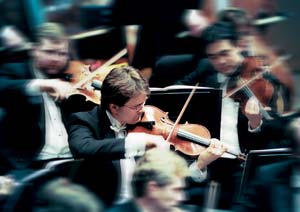
Snow might blanket the town for several months out of the year, but Minneapolis knows how to heat up the night. Minneapolis has produced an impressive list of nationally-known rockers like Prince, Hüsker Dü, and Semisonic, and the city still claims an active music scene. If you want to check out calendar listings before you arrive in town, City Pages is a good place to start.
First Avenue
If you’re visiting Minneapolis and you’re into music, you need to check out First Avenue. Prince got his start on its stage and the club is featured in the movie Purple Rain. It’s a cavernous space with walls that are painted pitch black, both inside and out. It hosts a wide array of musicians and I’ve been there for reggae night, salsa night, an Indigo Girls concert, a Cake concert, and spinning, whirling dance nights.
Fine Line Music Cafe
The Fine Line offers a live music experience a bit more upscale than First Avenue… but not always. The club is smaller but continually packs a crowd. You might find a place to sit, but you’ll just as likely find that all the tables have been pushed aside so everyone can dance. The Fine Line features great local bans alongside national acts.
Dakota Jazz Club
Arrive early at the Dakota Jazz Club to enjoy a fine sit-down dinner and good wine surrounded by exposed brick walls and dark wood moldings then stick around as the musicians on stage heat up the room for a smooth night of jazz. If you can’t make it for the evening show, pop in for happy hour and find yourself in the midst of relaxing corporate types as the Dakota is in the heart of downtown.
Orchestra Hall
If you’re looking for a refined music experience, perhaps a night at Orchestra Hall is in store; the Minnesota Orchestra calls Minneapolis home. Even if you don’t want to pass an evening listening to strings, Peavey Plaza, which is right outside Orchestra Hall, is a perfect place to bring a sandwich and eat outdoors in the sun.
If it’s a weekday, you’ll be accompanied by suited professionals as the plaza is downtown. And if you show up Monday-Friday at 5 pm in June, you can catch free live music and get dinner and beer from the nearby vendors.
Basilica Block Party
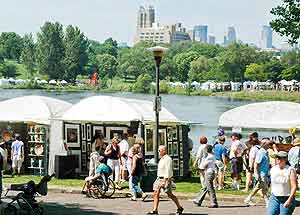
Come to town in July and hit the Basilica Block Party, an outdoor, weekend-long jam in the shadow of the city’s landmark Basilica of St. Mary. You can feel good about the ticket fee for hanging with the massive crowd: proceeds from the event fund the Basilica’s ongoing restoration.
Art Fairs
The people of Minneapolis celebrate summer and the season is host to a variety of activities designed to take advantage of the great outdoors. Art fairs abound in the sunny months, especially the first weekend of August, when three Minneapolis neighborhoods are overrun by art fairs, turning the southern half of the city into an art fair mania.
Uptown Art Fair
The Uptown Art Fair is consistently ranked as one of the top 10 art fairs in the country. Participating artists face stiff competition as the jury selection process has become more and more complex with the aim of featuring only quality fine art.
The crowds also ensure a force of food vendors and whole stretches of city blocks are barricaded to traffic. To ease parking concerns, the transit authority runs free busses between the Uptown fair and the two coinciding fairs listed below.
Powderhorn Art Fair
Powderhorn Park hosts its own art fair the first weekend in August. The artists here are also juried and they arrange their tents in an oblong circle about the banks of the park’s small lake. There are food tents, drink stands, music stages, and a sense of good cheer in the air.
It is certainly well-attended, yet the event also possesses a more laid-back aura as opposed to its more frenzied Uptown cousin.
Loring Park Art Fair

Loring Park also hosts an art fair over the same August weekend and its location just a few blocks from the city’s skyscrapers lends an excitement all its own.
Condo high-rises crowd the sky on one side, an Episcopal church with a tall bell tower marks another corner of the park, the impressive dome of the grand Basilica of St. Mary rises on another edge and the Sculpture Garden and Walker Art Center are just a bridge walk away. And of course, there is always the art, food, and music taking up the park itself.
Art-A-Whirl
Northeast Minneapolis is an artists’ enclave. Several massive, former warehouses have been renovated into individual studios, which now house workspace for hundreds of area artists. The artists throw open their doors, set out cookies and punch, and invite the public on a grand tour every third weekend of May.
Works are always for sale, but there’s no pressure to buy as the emphasis is on sharing. The whole thing is free, too.
Hotels
If you plan an art-lovers vacation in Minneapolis, you might as well carry the theme through to your hotel room. If you have the cash, that is. Le Meridien, which calls itself a Luxury Art Hotel, is one-of-a-kind in Minneapolis.
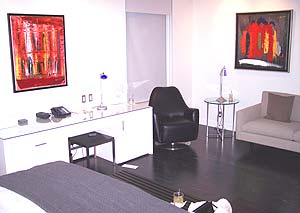
It is owned by the Burnets, a prominent Minnesota family that has invested heavily in the city’s art scene (the Loft, the Walker), and their love of modern art has carried through to their hotel. Each guest room features original works, and priceless art is on display throughout the hotel, including a gallery.
If you can’t afford the digs, which start at around $200, it’s worth your while to stop by for a drink or dinner. Try out the Mercy restaurant if you’re only in for a quick stop or an overnight stay.
Across the River
If you run out of things to do in Minneapolis, you can always hop the Mississippi and head to St. Paul, the state’s capital, and the second half of Minnesota’s “Twin Cities.”
Comparisons between the two cities abound, and if you ask a local what the difference is between Minneapolis and St. Paul, you’ll discover a variety of opinions and no one who thinks they are the same. Nonetheless, St. Paul has its own array of arty finds. Here’s a small sampling.
Minnesota Children’s Museum
If you’ve got wee ones in tow, you’ll want to hit the Children’s Museum. The interactive rooms feature tons of touch-and-feel activities for babes as young as 6-months old. It’s a busy place, so don’t expect to have an exhibit for yourself. You can expect, however, for your kids to leave good and tired.
Science Museum of Minnesota
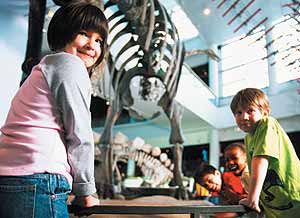
If your kids are a bit older, the Science Museum is a great way to pass a day. Heck, even if you’re kid-free, it’s still a fun place to be. There’s a mummy, a really big dinosaur, and tons of interactive experiments.
Traveling national exhibits routinely make their way through its galleries. Plus, the Omni Theater features a monster wrap-around screen that will make you feel like you’re rising and falling with the showing of any film.
Minnesota Museum of American Art
The Minnesota Museum of American Art got its start as a teaching museum. While it no longer considers education its primary focus, it hasn’t lost its desire to teach others about the art and offers a variety of workshops. Rotating exhibits are what’s on display and the themes tend to focus on region artists working in contemporary times or the more recent past.
Ordway Center for Performing Arts
The Ordway Center for the Performing Arts is home to the Minnesota Opera and the St. Paul Chamber Orchestra, but it also hosts touring musicals and regional acts. Come early and take a stroll through the adjacent Rice Park, which is surrounded by spectacular, historic buildings including the James J. Hill Reference Library, the Landmark Center, and the gracious St. Paul Hotel.
Additional Resources
The official convention and visitors association of Minneapolis offers tips and advice for travelers.
A local, alternative newspaper, City Pages tracks all sorts of events across town.
St. Paul Convention and Visitors’ Center
The official convention and visitors association of St. Paul offers tips and advice for travelers.
- Family Travel with Golfing in Iceland - December 23, 2016
- Beautiful Latin America with Kelly & Quang - August 10, 2016
- Packing Tips From ‘Round the World Travelers - August 18, 2012

